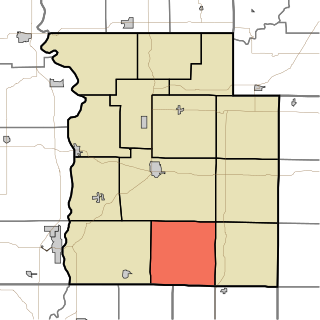Nordyke Marmon & Company was an American manufacturer of flour mills and located in Indianapolis, Indiana, United States.

The Mansfield Roller Mill or Mansfield Mill is a (gristmill) that was built in Mansfield, Indiana, United States by Jacob Rohm in 1875. This building replaced an older mill that dates back to 1821 built by James Kelsey and Francis Dickson;

The Mansfield Covered Bridge is a Double Burr Arch double span truss bridge located on Mansfield Road (historic) and Big Raccoon Creek in Mansfield southeast of Rockville in Parke County, Indiana. Built by Joseph J. Daniels in 1867 at a cost of $12,200. At 279 ft (85 m) it is the second longest covered bridge left in Parke County. This Historic Site rest on land provided by Luke Moody, of Parke County, Indiana and is open to the public all year.

The first Bridgeton covered bridge was a double-span Burr Arch bridge built in 1868 by a crew led by J. J. Daniels. It was closed to traffic in 1967. It was built to replace two prior open wooden bridges that had fallen in. After its destruction by fire, it was replaced in 2006 by a reproduction.

The Nevins Covered Bridge is a single span Burr Arch Truss covered bridge that crosses Little Raccoon Creek on County Road 130 East, just southeast of Catlin, Indiana. It was built in 1920 by Joseph A. Britton and Son. Prior to the reconstruction of the Bridgeton Bridge in 2006, the Nevins Bridge was the newest covered bridge in Parke County.

The covered bridges of Parke County are well-known tourist attractions in Parke County, Indiana, United States, which touts itself as the "Covered Bridge Capital of the World". The county claims to have more covered bridges than any other county in the United States. This is due to several reasons, mainly due to the numerous streams and creeks in the county, and having the natural resources and designers to build the bridges.

The Jackson Covered Bridge also known as the Rockport Covered Bridge is located in the 'forgotten town' of Rockport, northwest of Bloomingdale, Parke County, Indiana, USA.

The Portland Mills Covered Bridge is the second oldest covered bridge in Parke County, Indiana, being built the same year as the Crooks Covered Bridge. It is a single span Burr Arch Truss covered bridge that was built by Henry Wolf in 1856.

The Wilkins Mill Covered Bridge is north of Rockville, Indiana. The single span Burr Arch Truss covered bridge structure was built by William Hendricks in 1906. The bridge is 120 feet (37 m) long, 16 feet (4.9 m) wide, and 13 feet (4.0 m) high.

Raccoon Township is one of thirteen townships in Parke County, Indiana, United States. At the 2010 census, its population was 659 and it had 345 housing units.

Framsden Windmill is a Grade II* listed post mill at Framsden, Suffolk, England which is preserved. The mill was known as Webster's Mill when it was a working mill.
Joseph Albert Britton (1839–1929), most commonly known as J.A. Britton, was a builder of bridges in Indiana. He created many works that survive and are listed on the U.S. National Register of Historic Places.

The Neligh Mill is a water-powered flour mill in the city of Neligh in the northeastern part of the state of Nebraska in the Midwestern United States. The mill was built in 1873 by John Neligh, the city's founder, to make use of water power from the Elkhorn River. It operated for nearly one hundred years until it closed in 1969.
The Armiesburg Covered Bridge was on the south side of Armiesburg, Indiana. The Long Truss with arch covered bridge structure was built by Henry Wolf in 1907 and destroyed by the Great Flood of 1913.
The Dooley Station Covered Bridge was east of Dooley Station, Indiana. The Burr arch truss style single span covered bridge crossed Little Raccoon Creek and was built by W.C. Carty in 1917 and destroyed by arson in 1960.

Drinkwater & Schriver Mill, also known as Cedar Point Mill, was listed on the National Register of Historic Places (NRHP) in 2006. It is located in Cedar Point, Kansas, United States.

The Motor Mill Historic District is a nationally recognized historic district located southeast of Elkader, Iowa, United States. It was listed on the National Register of Historic Places in 2014. In 1977 it had been listed as a contributing property in the Motor Townsite.

Hodgson-Aid Mill, also known as Hodgson Water Mill and Aid-Hodgson Mill, is a historic grist mill located on Bryant Creek near Sycamore, Ozark County, Missouri. It was constructed around 1897, and is a 3+1⁄2-story, timber frame mill building covered with red-painted weatherboards. Associated with the mill are the man-made mill pond and the limestone barrel vault constructed at the base of the cliff where Hodgson Spring discharges. The mill has not been in operation since 1976. It is privately owned.
Snoddy's Mill was a historic grist mill located at Wabash Township, Fountain County, Indiana.

Dunham's Mill, also known as Parry's Mill, is a historic building located at 7 Lower Center Street in Clinton, New Jersey, United States. The gristmill was in operation from 1837 to 1952. It was added to the National Register of Historic Places on April 15, 1982, for its significance in commerce and industry. In 1995, it was also listed as a contributing property of the Clinton Historic District. It shares the Clinton Dam across the South Branch Raritan River with the David McKinney Mill on the other side of the river. Since 1952, it has been home to the Hunterdon Art Museum, described by an art critic as the "most charming and picturesque" museum in the state.




















